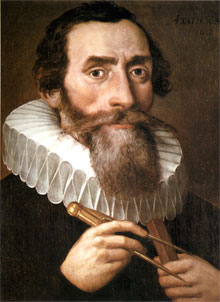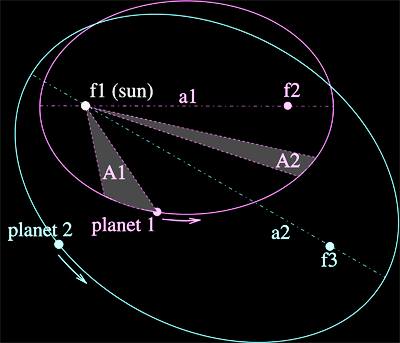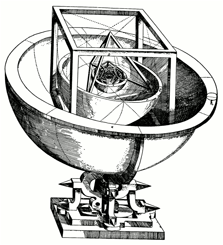
Kepler
Johannes Kepler (27 Dec 1571 – 15 Nov 1630) laid, with Galileo, the foundation of the Scientific Revolution. He was an astronomer and mathematician, but he was also an astrologer, at a time when astrology and astronomy were inseparably combined. From Tycho Brahe’s astronomical observations of the orbit of Mars, Kepler was led to the conclusion that the planets executed elliptical orbits about the Sun, positioned at one their foci. This marked a decisive break with the tradition in astronomy, from the pre-Socratics through Ptolemy and down to Copernicus (but with the exception of Nicholas of Cusa), according to which celestial motions should conform to the most perfect of geometric figures, the circle. Kepler’s theory of elliptical orbits appeared in his Astronomia Nova in 1609.
The discovery of the elliptical orbits of the planets was encoded in the first of the three laws that bear Kepler's name. The second law stated that the line joining each planet to the sun sweeps out equal areas in equal times. As Newton later showed, the equal areas law follows for any centripetal force law (it is a direct consequence of the principle of conservation of angular momentum). Kepler’s third law stated that the square of the period of orbit, divided by the cube of the major axis, is the same for each planet. It is this that is the signature of an inverse square law.
 |
Kepler’s 2nd law states that the areas A1 and A2 are swept out in equal times; the 3rd that the ratio of the squares of the period of the orbits of planets 1, 2 equals the ratio of the cubes of the lengths of the dotted lines a1 and a2. |
Kepler’s first astronomical treatise of 1596, the Mysterium Cosmographicum (‘Cosmographic Mystery’) was based on the model of perfectly circular orbits. It was the first major work to defend Copernicus’s heliocentric system. In it he derived the relative ratios of the radii of the planetary orbits according to his famous construction of a nesting of the five Platonic solids. The largest sphere contained in the innermost Platonic solid corresponded to the orbit of Mercury; that which bounded it and was in turn bounded by the next Platonic solid was the sphere defined by the orbit of Venus; and so on to the orbit of the Earth, Mars, Jupiter, and Saturn, which defined the sphere bounding the last of the five Platonic solids. For the sequence octahedron, icosahedron, dodecahedron, tetrahedron, and cube, he found approximate agreement with the ratios derived from Copernicus’ system (these ratios were the 'mystery' of cosmography, according to Kepler). Copernicus’ system, in contrast to Ptolomy’s, related the ratios of the orbital radii to the observable data -- the relative angles subtended by the planets at the Earth's surface.
Kepler retained his system of nested Platonic solids even when replacing circular orbits by elliptical ones. Indeed, much of his subsequent work was directed to improving his solution to the ‘cosmographic mystery’. (Of course these ratios are now regarded as largely contingent, and their approximate agreement with Kepler's nesting of Platonic solids, coincidental.)
 Kepler also made important contributions to optics and to mathematics. His Astronomiae Pars Optica of 1604 included, among other discoveries, the inverse square law for the fall-off in intensity of a point source of light. In his Dioptrice of 1611 he set out much of the theory of classical optics, including the theory of the Galilean and Keplerian telescopes.
Kepler also made important contributions to optics and to mathematics. His Astronomiae Pars Optica of 1604 included, among other discoveries, the inverse square law for the fall-off in intensity of a point source of light. In his Dioptrice of 1611 he set out much of the theory of classical optics, including the theory of the Galilean and Keplerian telescopes.
Kepler was born near Stuttgart in Germany. His father was a mercenary, his mother a healer and herbalist, later tried (and acquitted) for witchcraft. He early showed talent in mathematics. Having attended grammar school and seminary at Maulbronn, he studied mathematics, philosophy and theology at the University of Tübingen. He was appointed to the University of Graz to teach astronomy and mathematics in 1594. In 1600 he became assistant to Tycho Brahe at his observatory near Prague. Following Tycho’s sudden death in 1601, he was appointed to replace him by the Emperor Rudolph II.
Links
Stanford Encyclopedia of Philosophy >
Multimedia
Astronomy Cast: Johannes Kepler and his laws of planetary motion >
